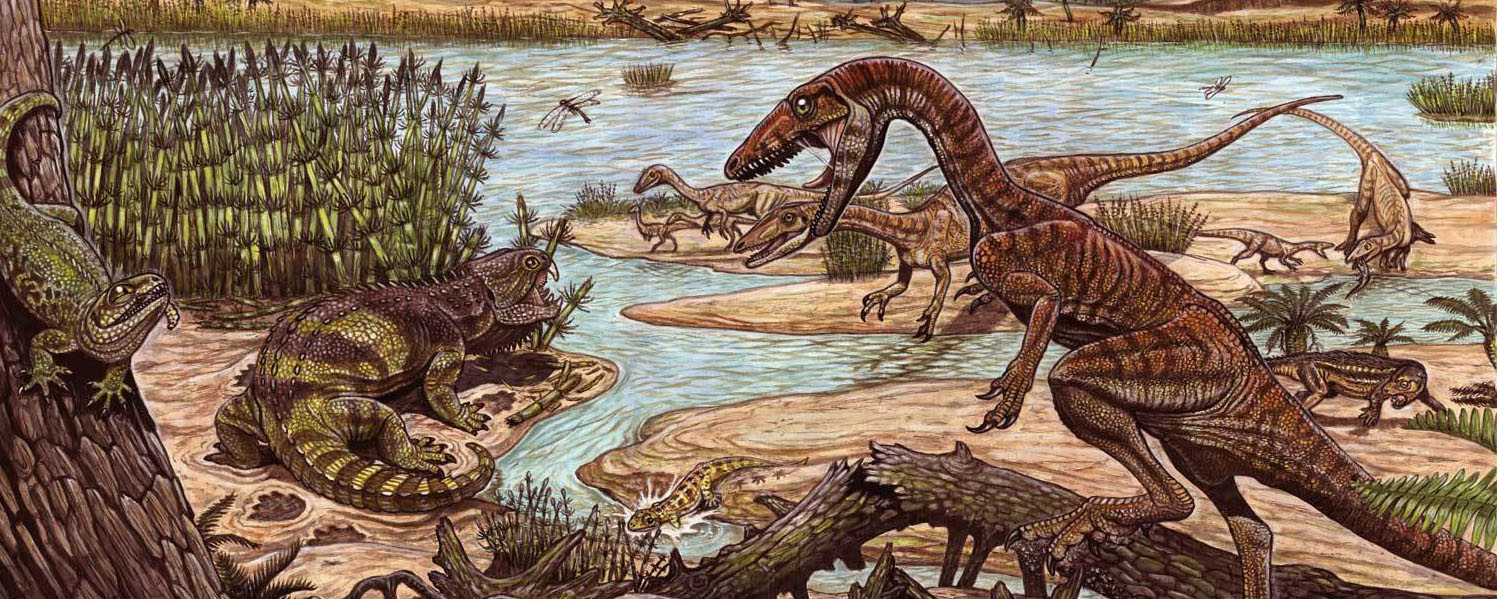

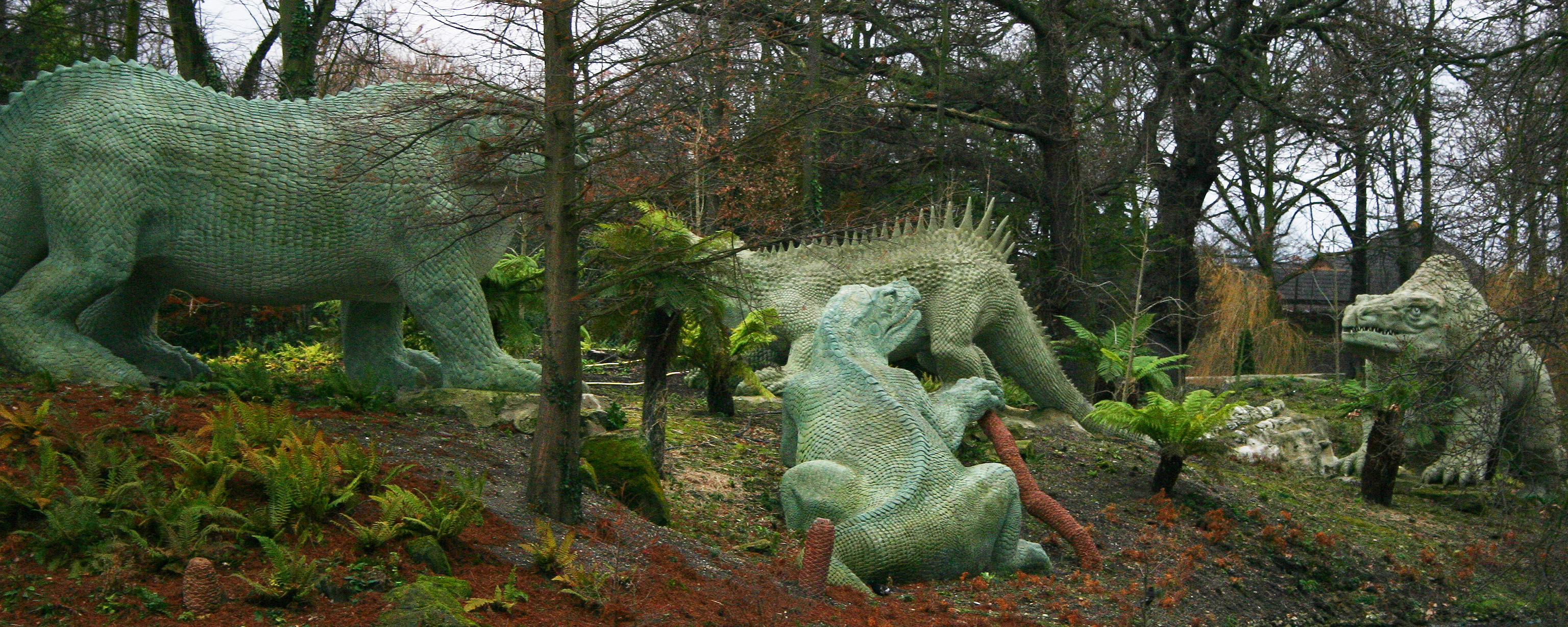
"The combination of such characters, some, as the sacral ones, altogether peculiar among
Reptiles, others borrowed, as it were, from groups now distinct from each other, and all
manifested by creatures far surpassing in size the largest existing reptiles, will, it be presumed,
be deemed sufficient ground for establishing a distinct tribe or sub-order of Saurian Reptiles,
for which I would propose the name of Dinosauria." -- Sir Richard Owen, 1842, "British Fossil Reptiles"
and
"The Dinosaurs, having the same thoracic structure as the Crocodiles, may be concluded to have possessed a four-chambered heart; and, from their superior adaptation to terrestrial life, to have enjoyed the function of such a highly-organized centre of circulation to a degree more nearly approaching that which now characterizes the warm-blooded Vertebrata." -- (also from) Sir Richard Owen, 1842, "British Fossil Reptiles"
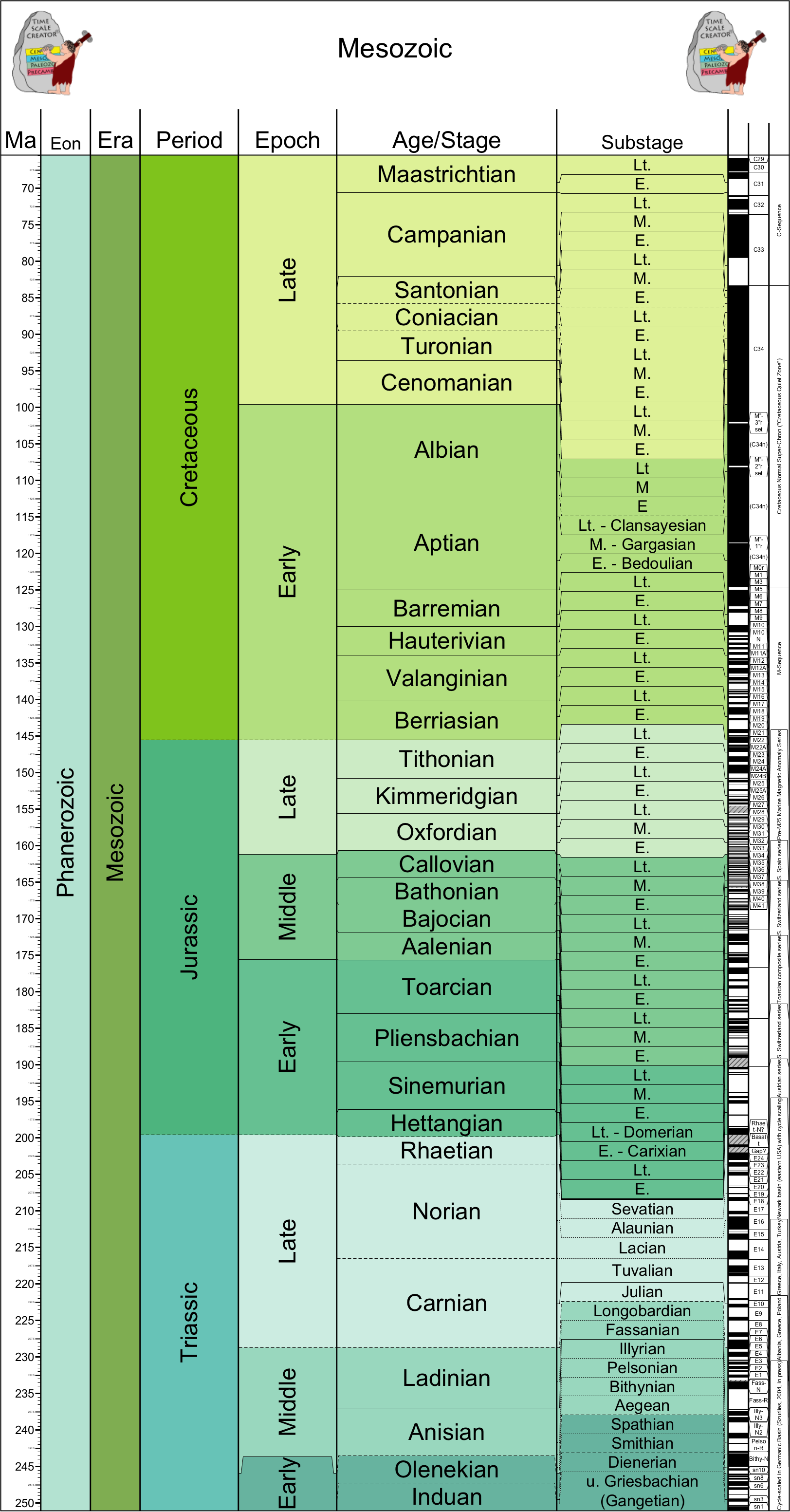
BIG QUESTION: How did dinosaurs become so successful?
Discovery of the Age of Reptiles
During the late 18th and early 19th Century paleontologists had discovered numerous fossil reptiles from what was then the "Secondary" Era (Mesozoic by today's standards). These included mosasaurs, ichthyosaurs, and plesiosaurs (all marine reptiles) and pterosaurs (flying reptiles). It became clear that there was no major presence of large bodied mammals in air or sea at this time, unlike as in the Cenozoic.
In the early 19th Century, a series of discoveries in England demonstrated the existence of large terrestrial animals during this "Age of Reptiles": carnivorous Megalosaurus and herbivorous Iguanodon. Although only known from fragmentary skeletons, they indicated the presence of giant land lizard-like animals. In 1842, paleontologist united these two and armored Hylaeosaurus as the Dinosauria (Latinized Greek for "fearfully great lizards"), distinct from all other living and extinct reptiles from their fully upright hindlimbs (more like a mammal than a lizard or crocodilian) and their large size (see quote at top).
Subsequent discoveries from all over the world revealed an astonishing diversity of form among the dinosaurs. Some of these included the largest land-dwelling animals of all time, with masses of about 100 tons; others were much, much smaller.
The present definition of Dinosauria is "the clade comprised of Iguanodon, Megalosaurus, Diplodocus, their concestor, and all of its descendants". This definition doesn't require dinosaurs to be big, scaly, land-dwelling, or extinct: in fact, as we will see, there are dinosaurs that are none of these.
Prior to March 2017, 130 years of research and 35 years of phylogenetic analyses supported uniting Sauropodomorpha and Theropoda into Saurischia:
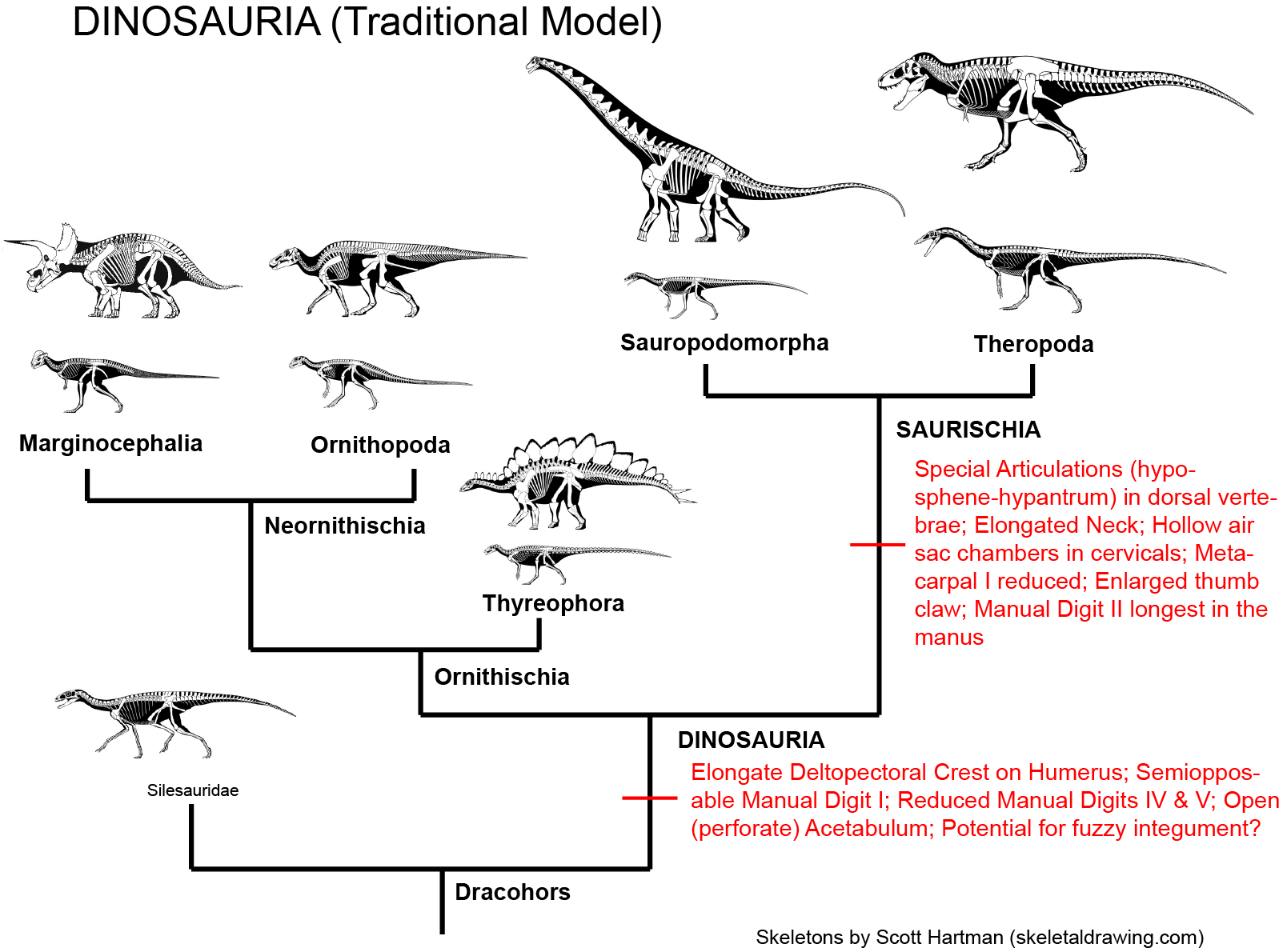
While this is still a distinct possibility, a recent study suggested alternatively that Ornithischia and Theropoda were sister taxa, making "Saurischia" paraphyletic. And there are some traits that have suggested that sauropodomorphs and ornithischians are closer to each other than either are to theropods (but to be fair no numerical cladistic analysis has yet produced this as the most parsimonious result). Here are these alternatives:
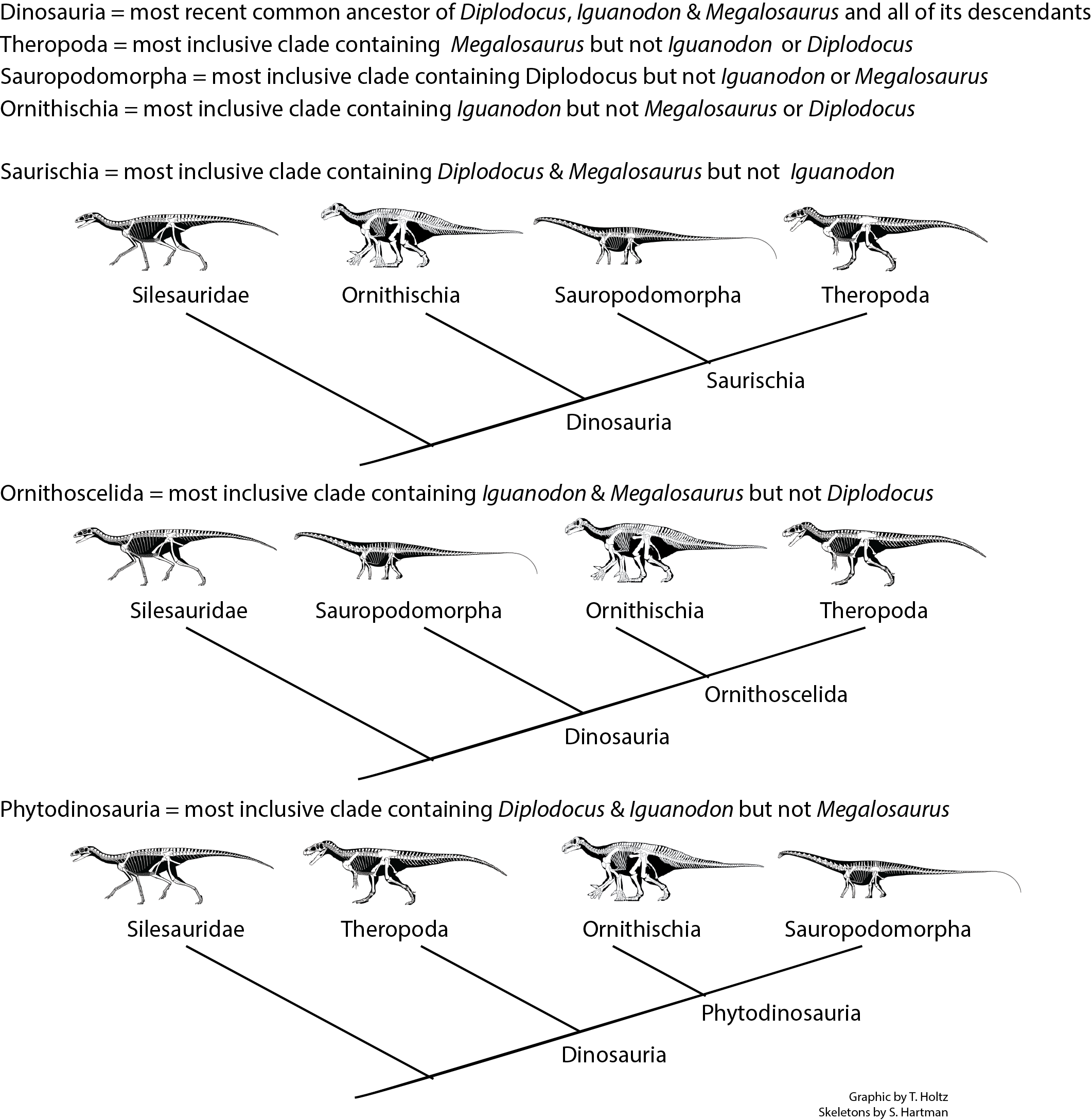
Dinosauria first appears at the beginning of the Late Triassic (c. 235 Ma). Dinosaurs divide into three major clades:
Among the many diverse forms of Ornithischia:
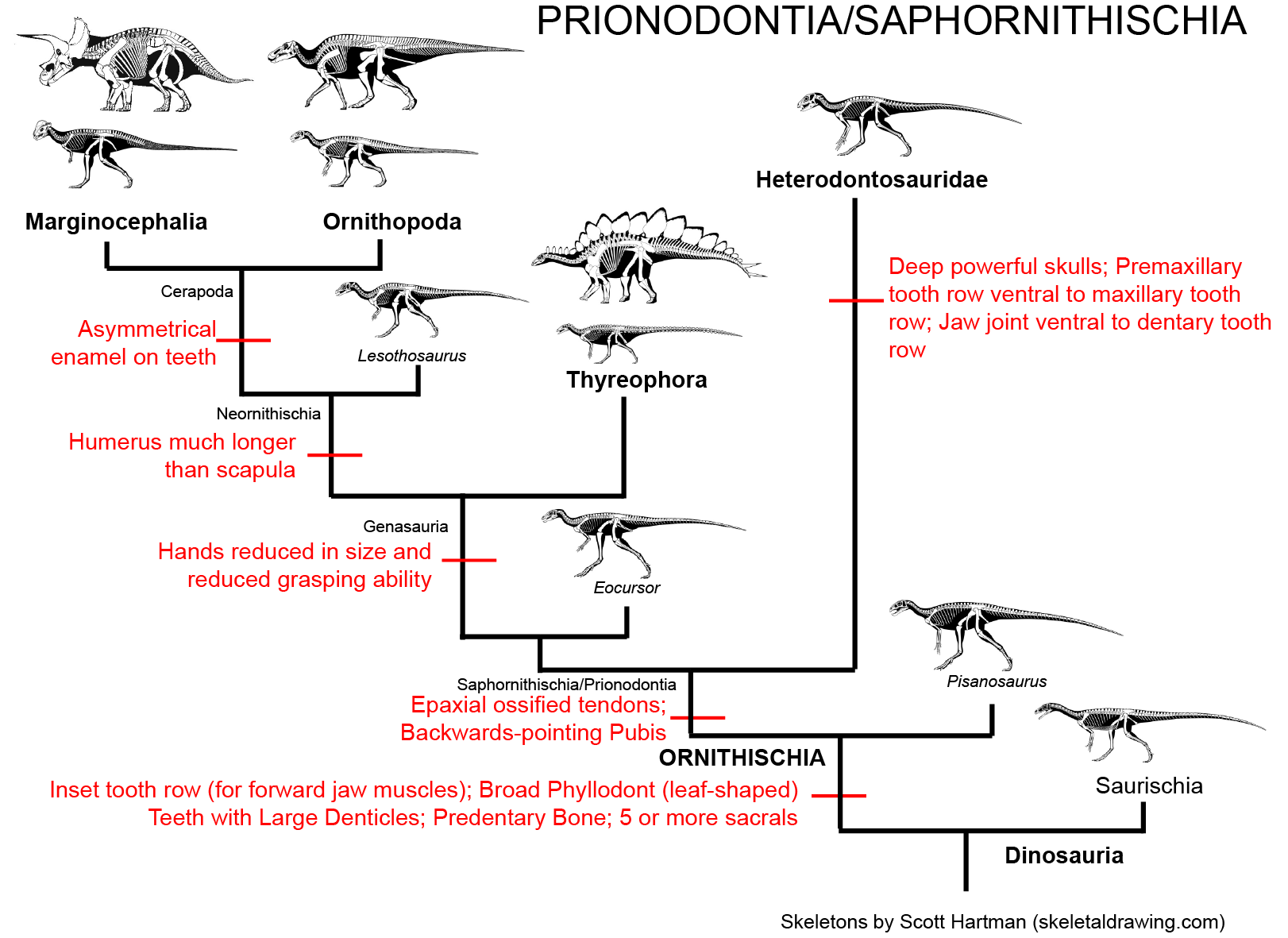
were the armored Thyreophora:
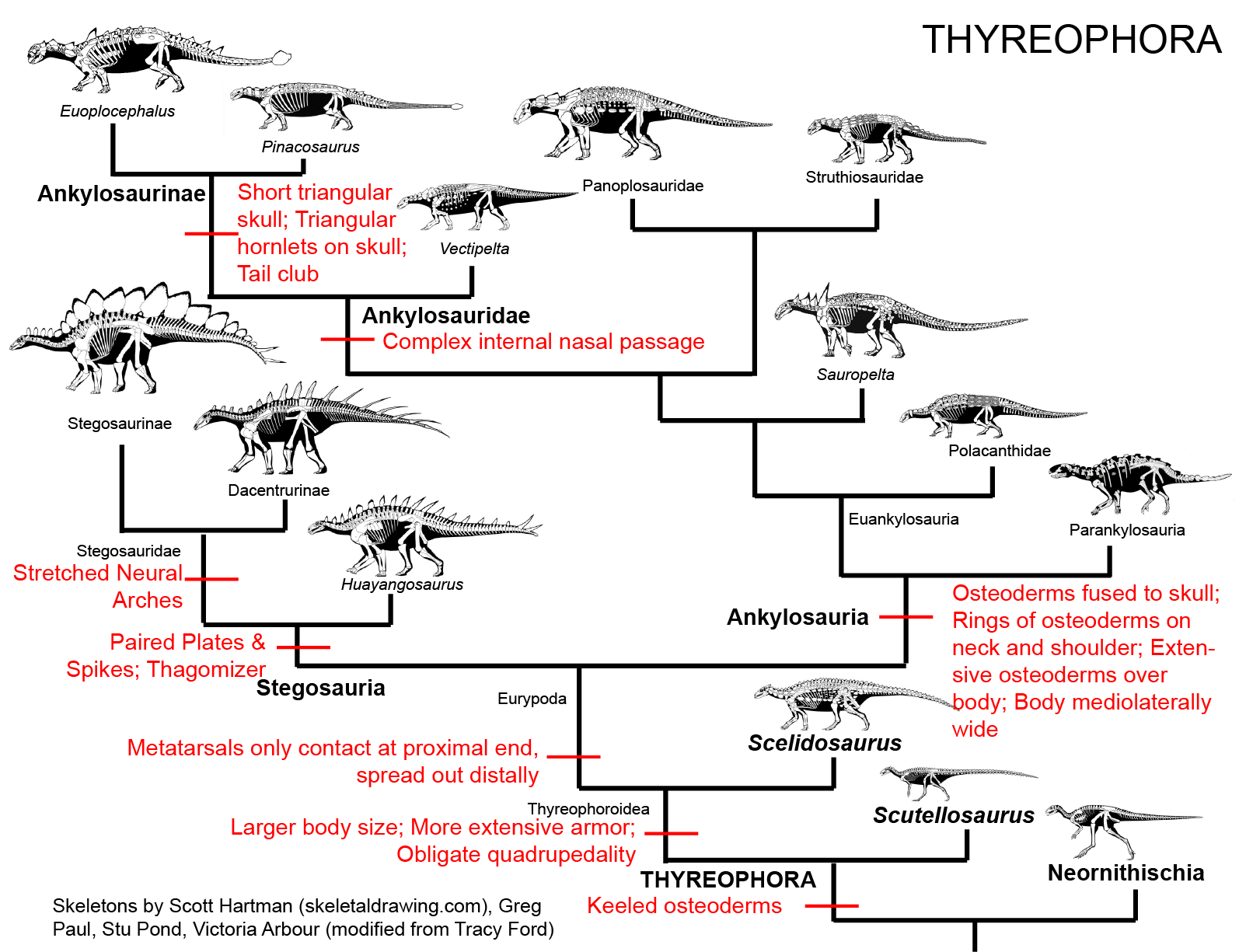
the beaked Ornithopoda:
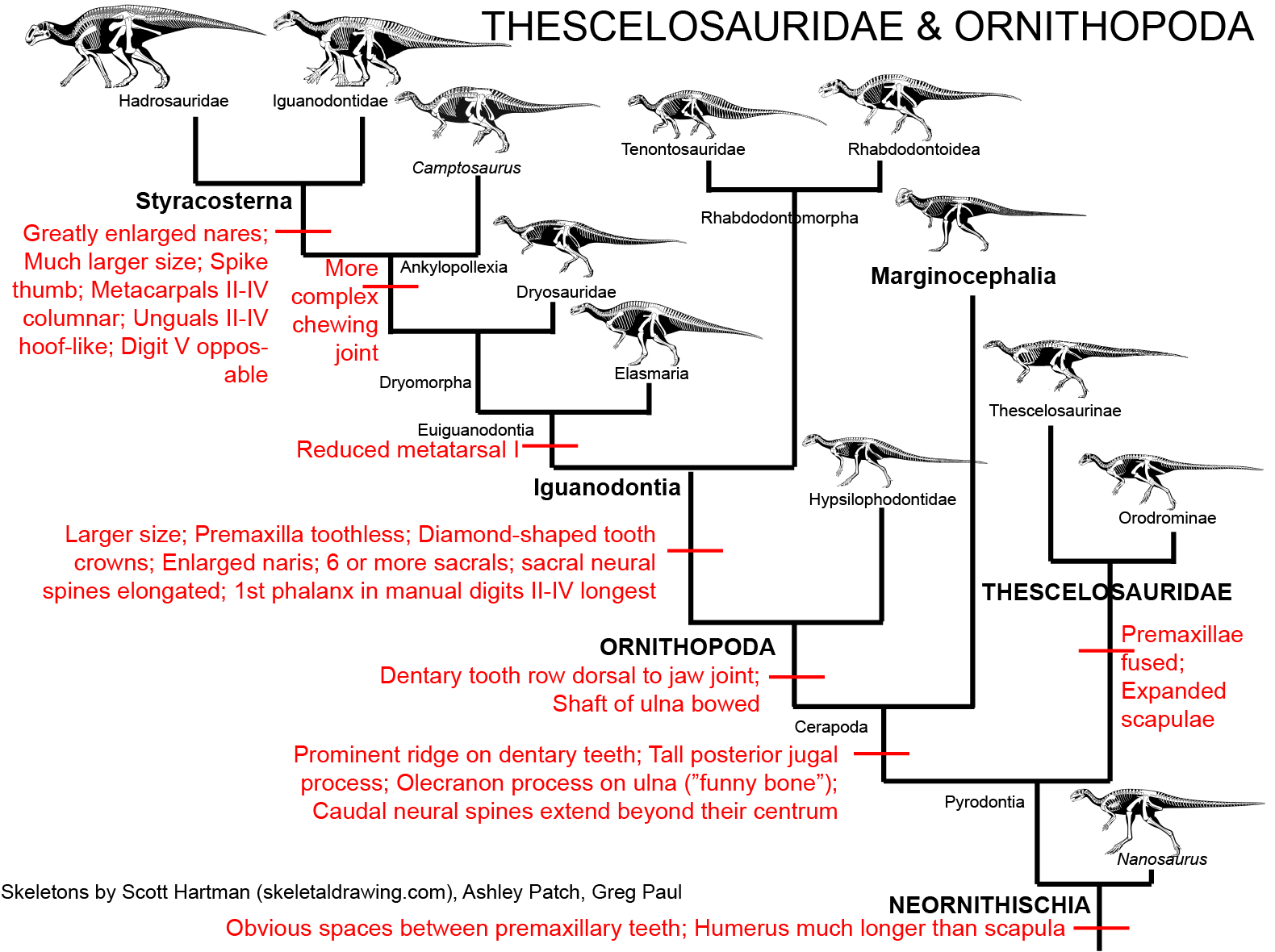
(including the highly derived duckbilled Hadrosauridae (or "duckbills")):
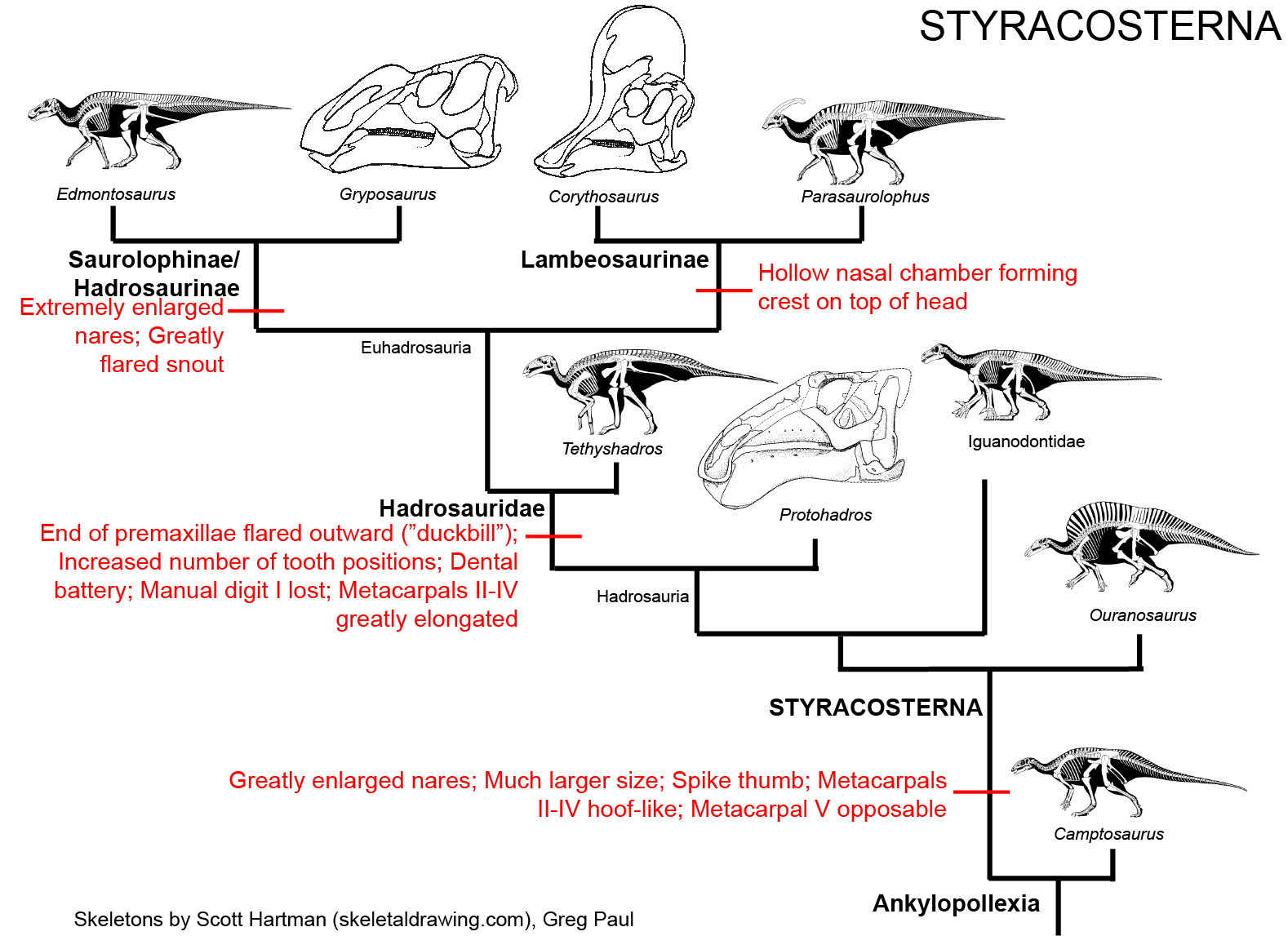
and the ridge-headed Marginocephalia:
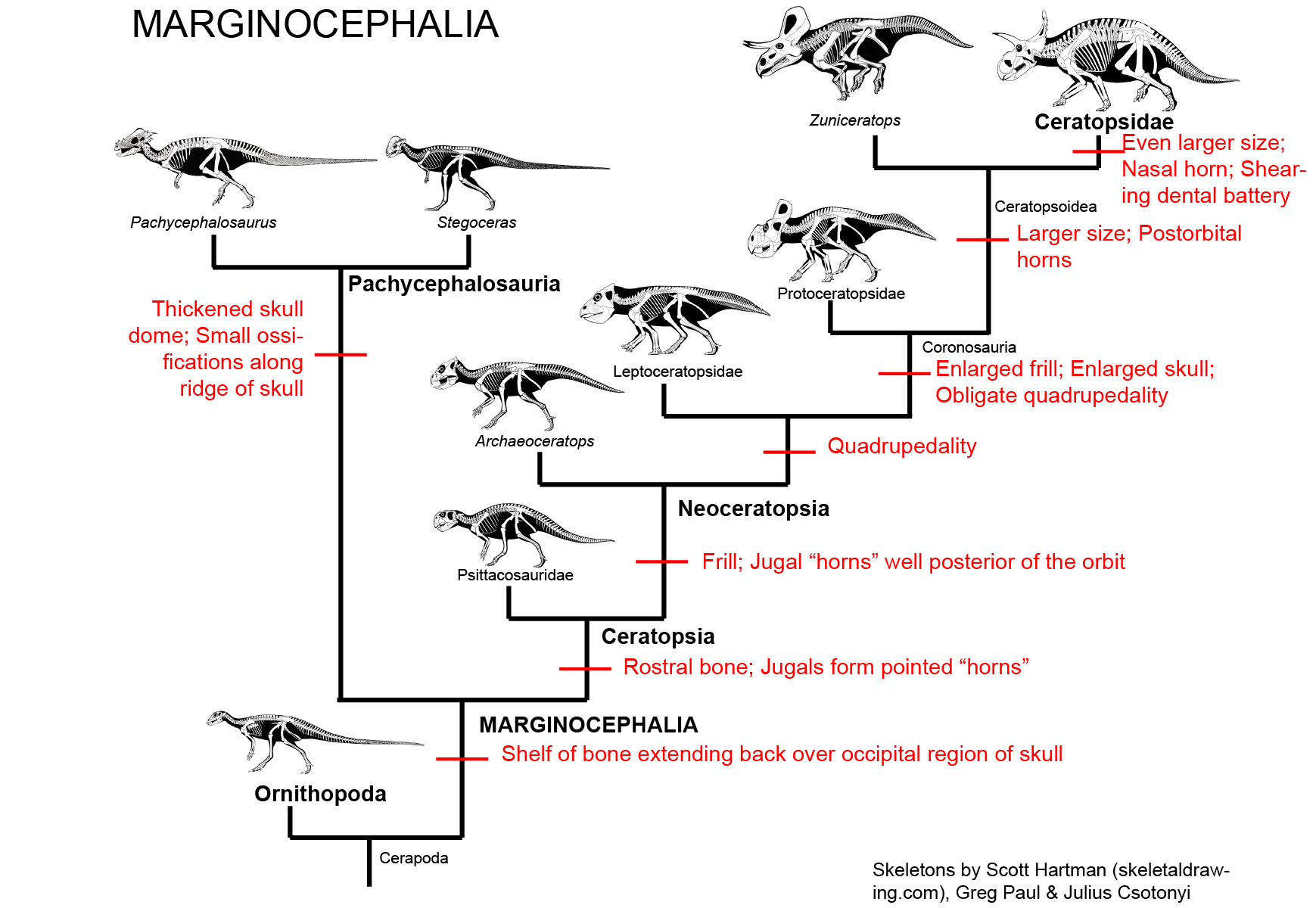
(including the specialized horned Ceratopsidae):
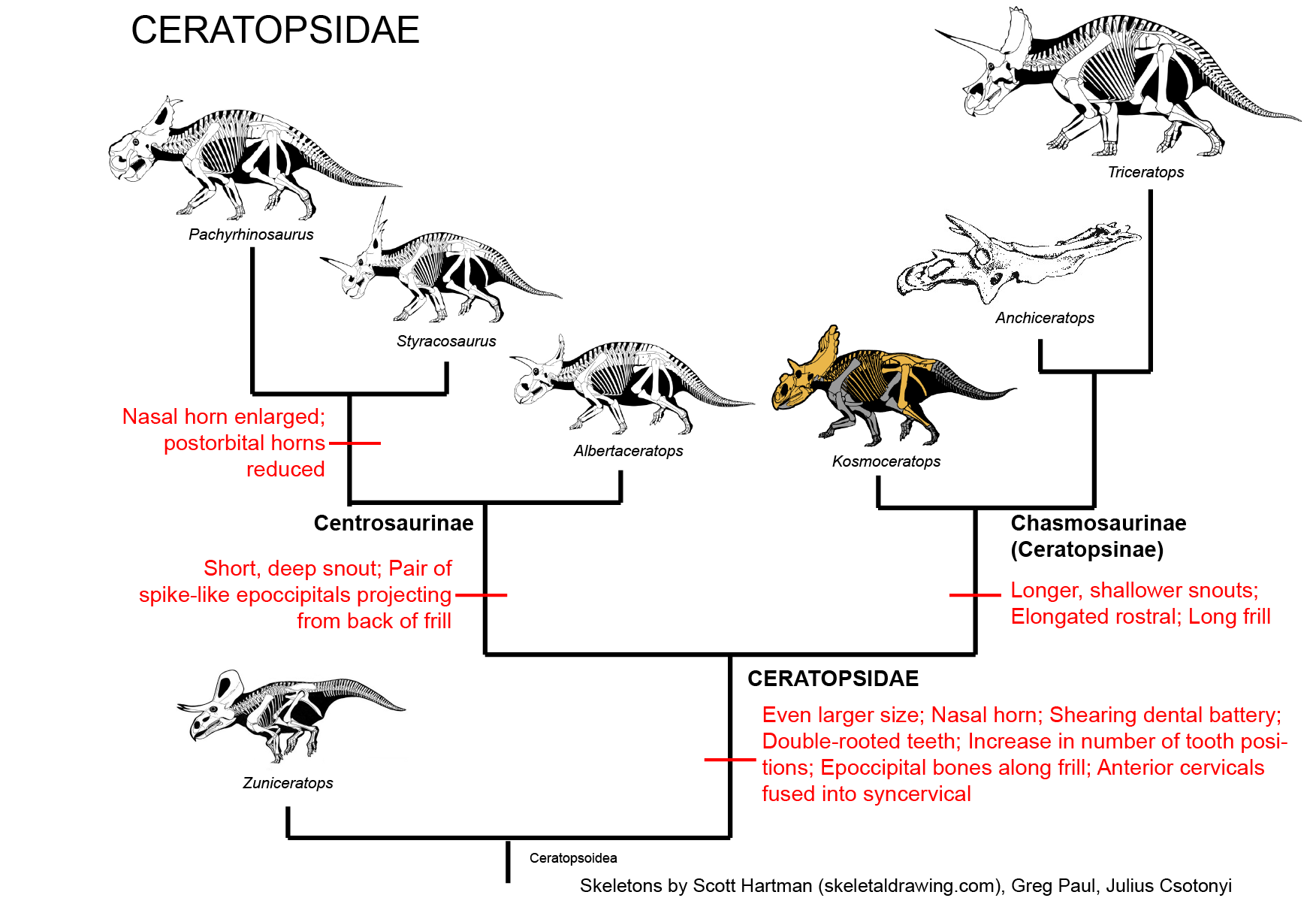
Among the various clades of Saurischia were the elongate-necked Sauropodomorpha:
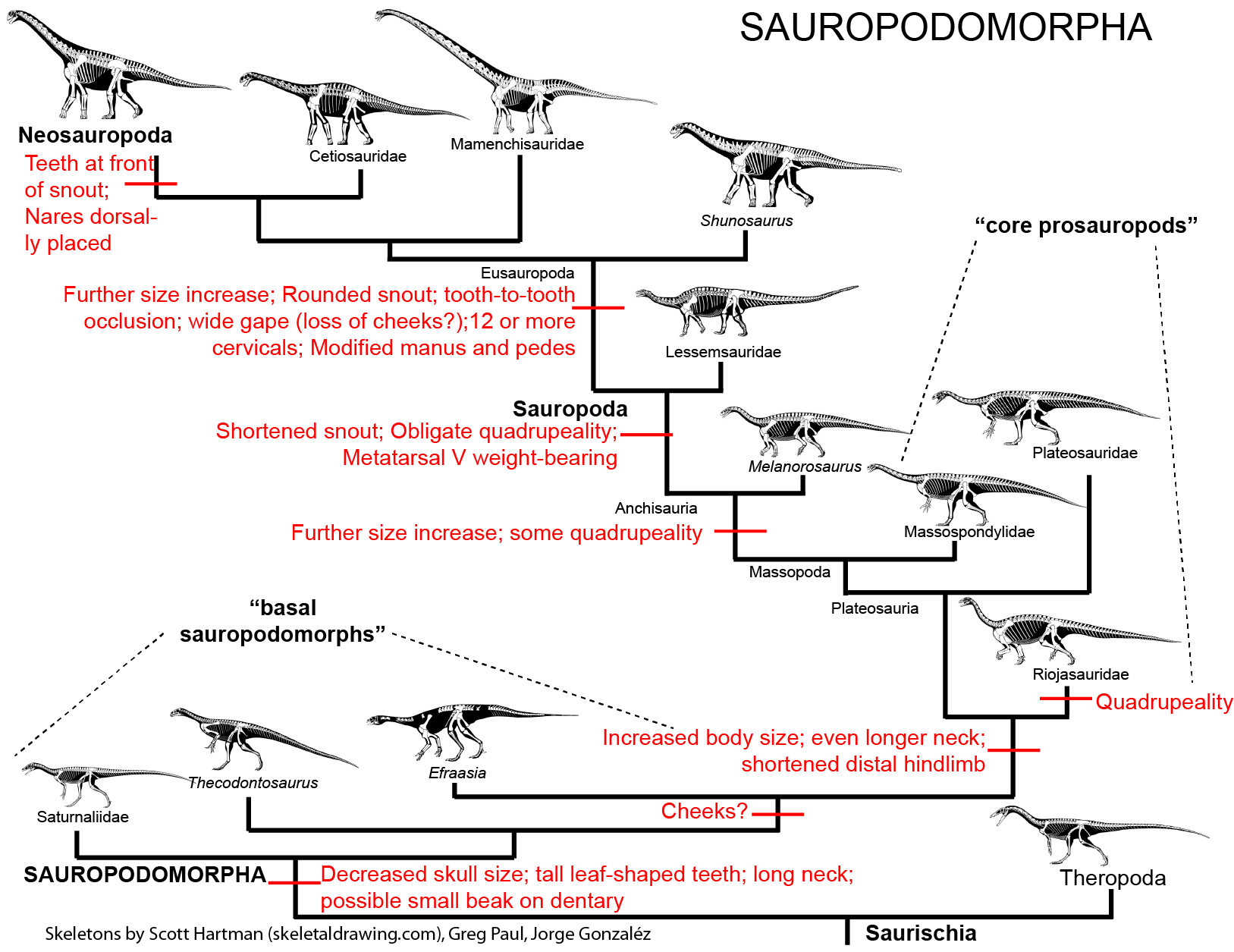
(including the Sauropoda, the largest land-animals of all):
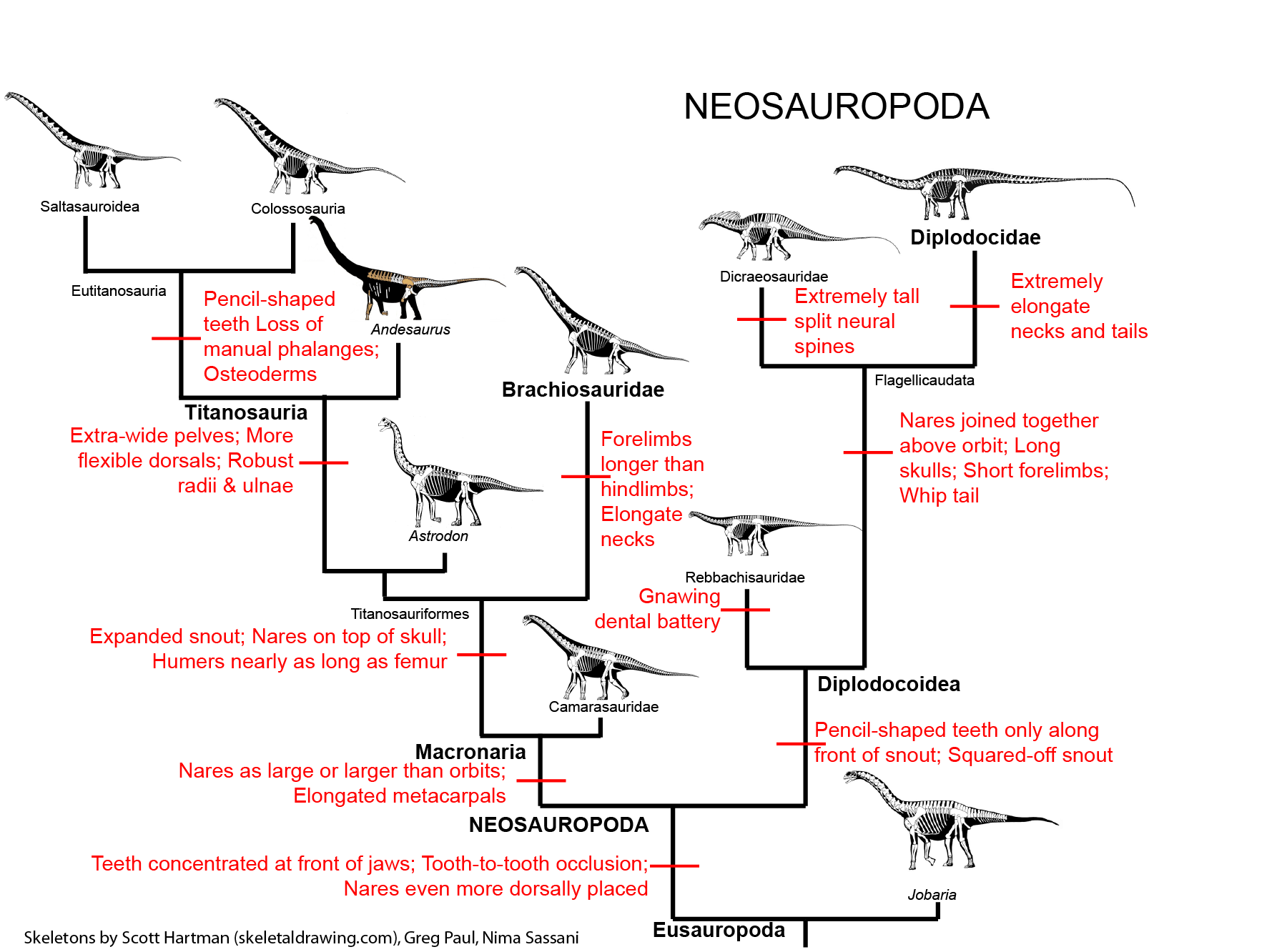
And the various subdivisions of Theropoda, from primitive stages:
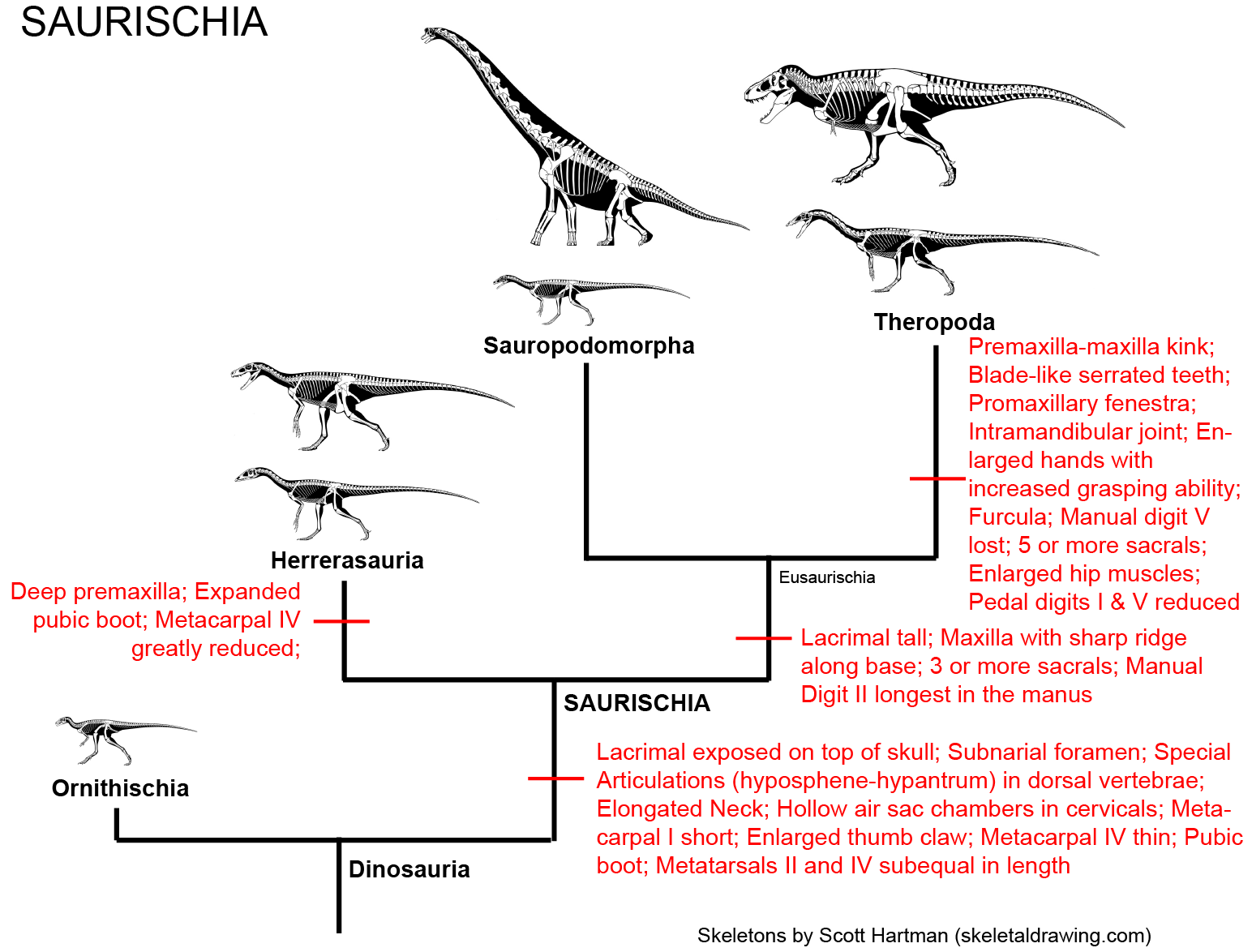
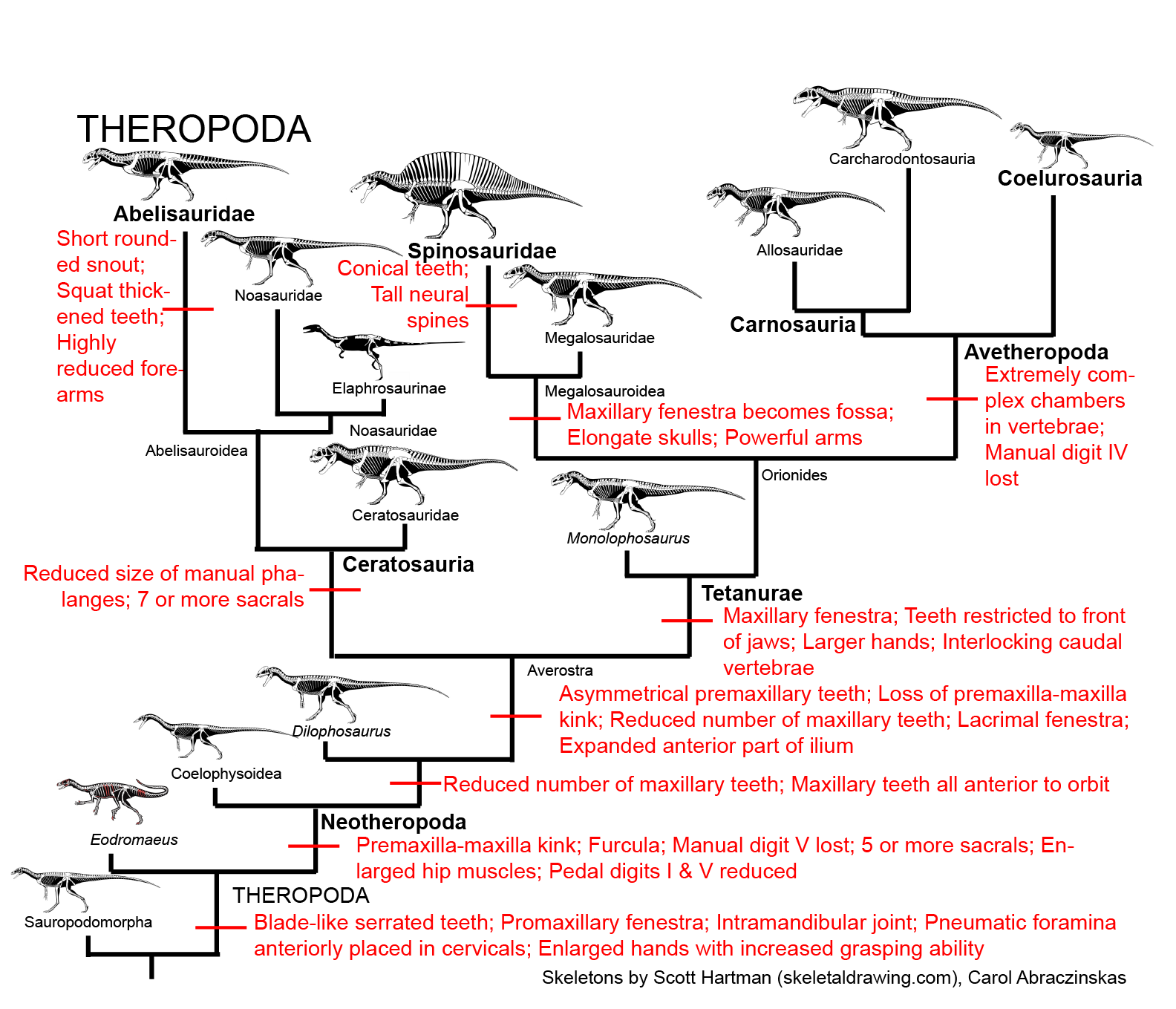
and the specialized feathered Coelurosauria, some of which were giant predators but many of which had shifted from eating meat to eating plants, insects, and the like:
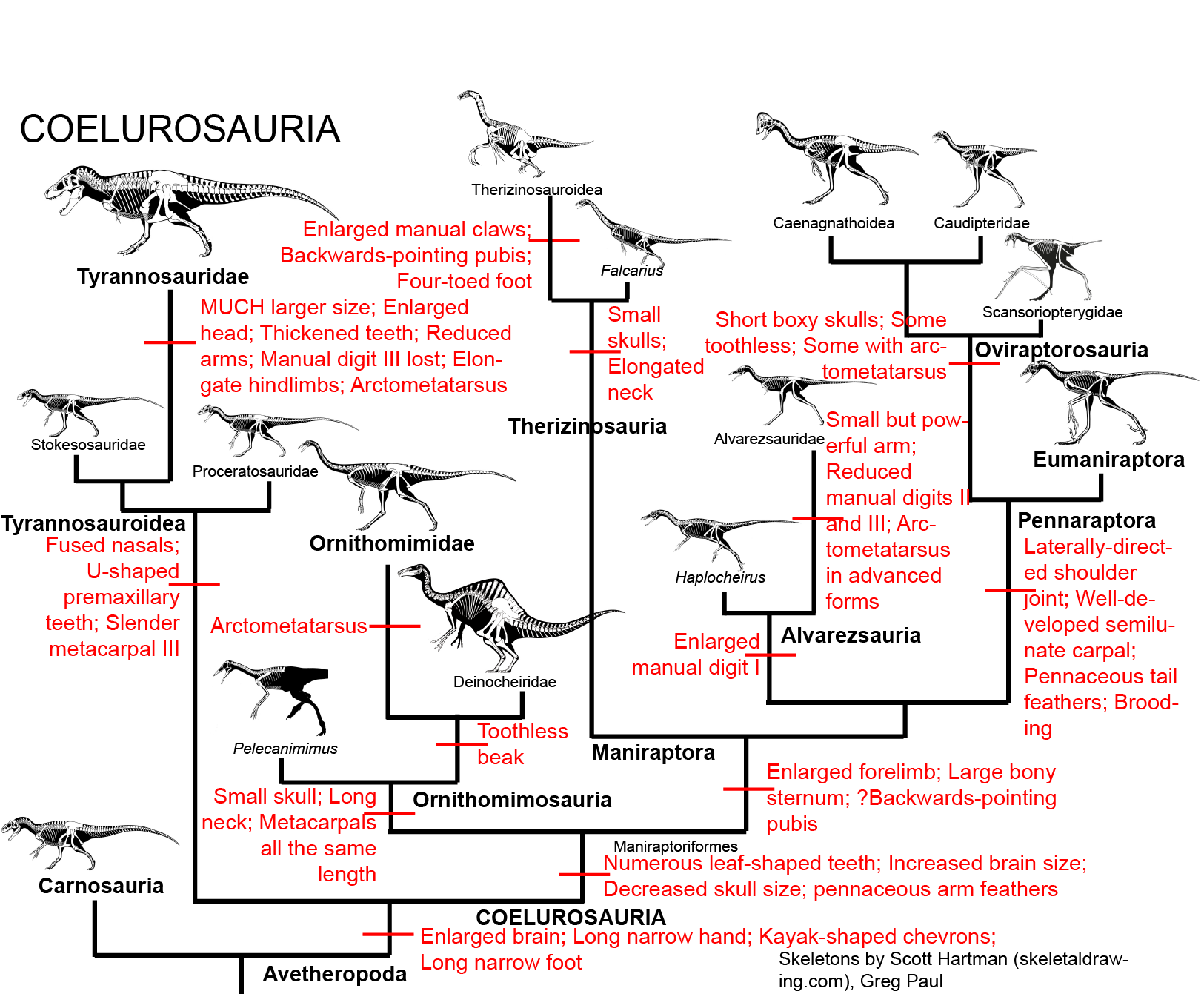
Among the most derived of the coelurosaurs were the Dromaeosauridae and Troodontidae (sometimes regarded as a single clade Deinonychosauria ("raptors")) and their sister group Avialae, or birds:
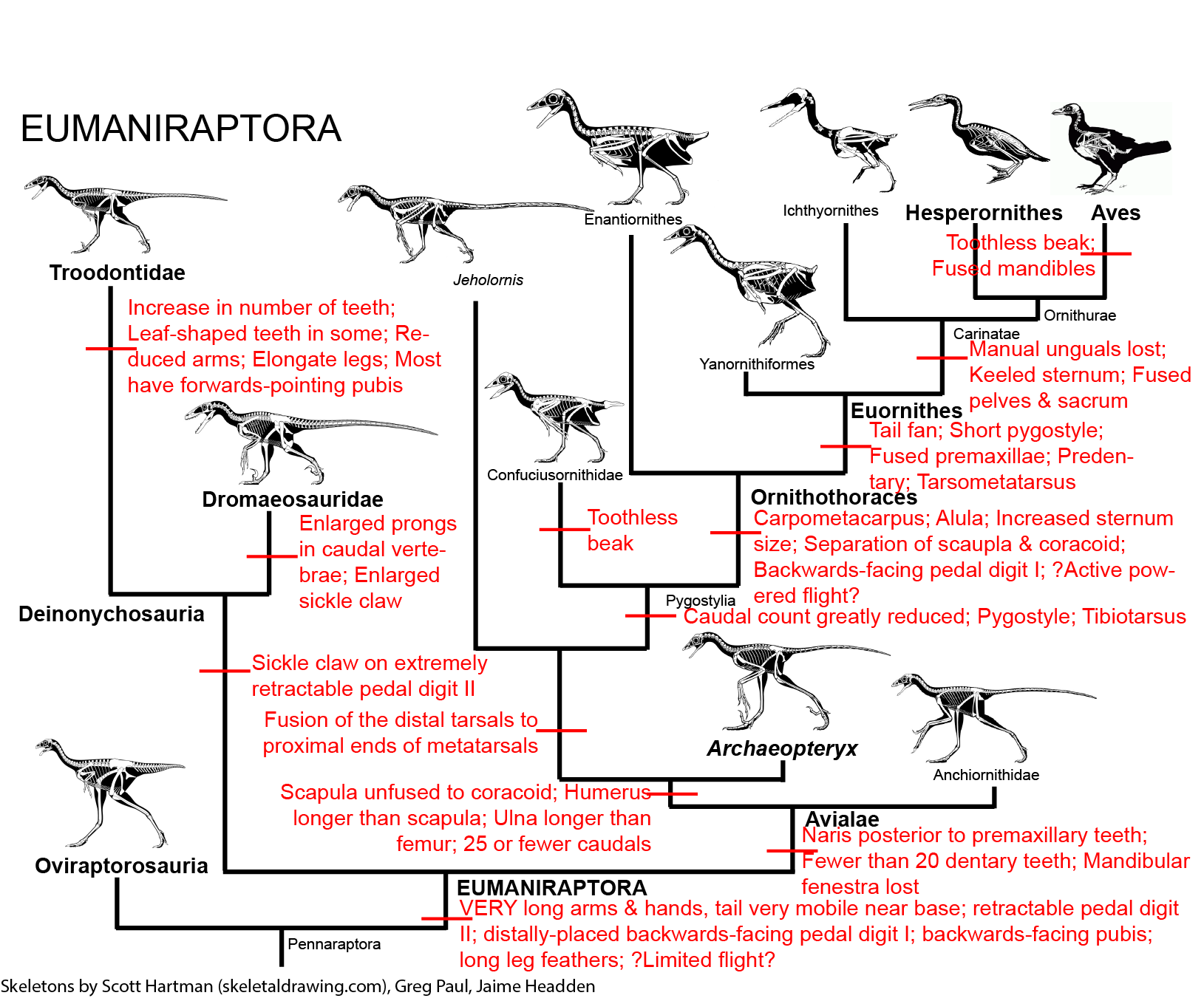
Yes, cladistically, all birds living and extinct are a type of dinosaur!
Famously, at least some dinosaurs were gigantic. It isn't just that some dinosaurs were large. It is that giant (>1 t) size is fairly common in dinosaur groups, and that >5 t size occurs in both carnivorous and ornithischian dinosaurs (with many independent cases), and that >10 t is actually a STANDARD body size for the sauropod dinosaurs! Indeed, the very largest dinosaurs reached masses of 80-100 t (or, in other words, the mass of a herds of elephants!). In contrast, where there have been a few 10 t land mammals, most mammals were much smaller. (Of course, even dinosaurs were dwarfed by the modern blue whale).
That said, there were many small dinosaurs, too. The first dinosaurs were about 1-1.5 m long, and half that length was tail. And some were smaller than that.
Dinosaur fossils have been found on every continent.
In the wake of the Permo/Triassic Mass Extinction (the greatest extinction in the history of life, ecosystems on land and sea were clobbered. In the immediate aftermath, there was a great reduction in size and diversity of the animals present.
Lost were many of the primitive therapsid proto-mammals and many of the primitive reptiles.
During the Early Triassic diversity started off very low in land and sea, and recovered over the next ten million years or so. On land, more advanced carnivorous therapsids were the dominant predators, and piglet to ox-sized herbivorous therapsids were common. But the sauropsids (and especially diapsids) began to radiate into the number of different forms:
These new predators were the precursors of Archosauria ("ruling reptiles"), the dominant group of Mesozoic sauropsids.
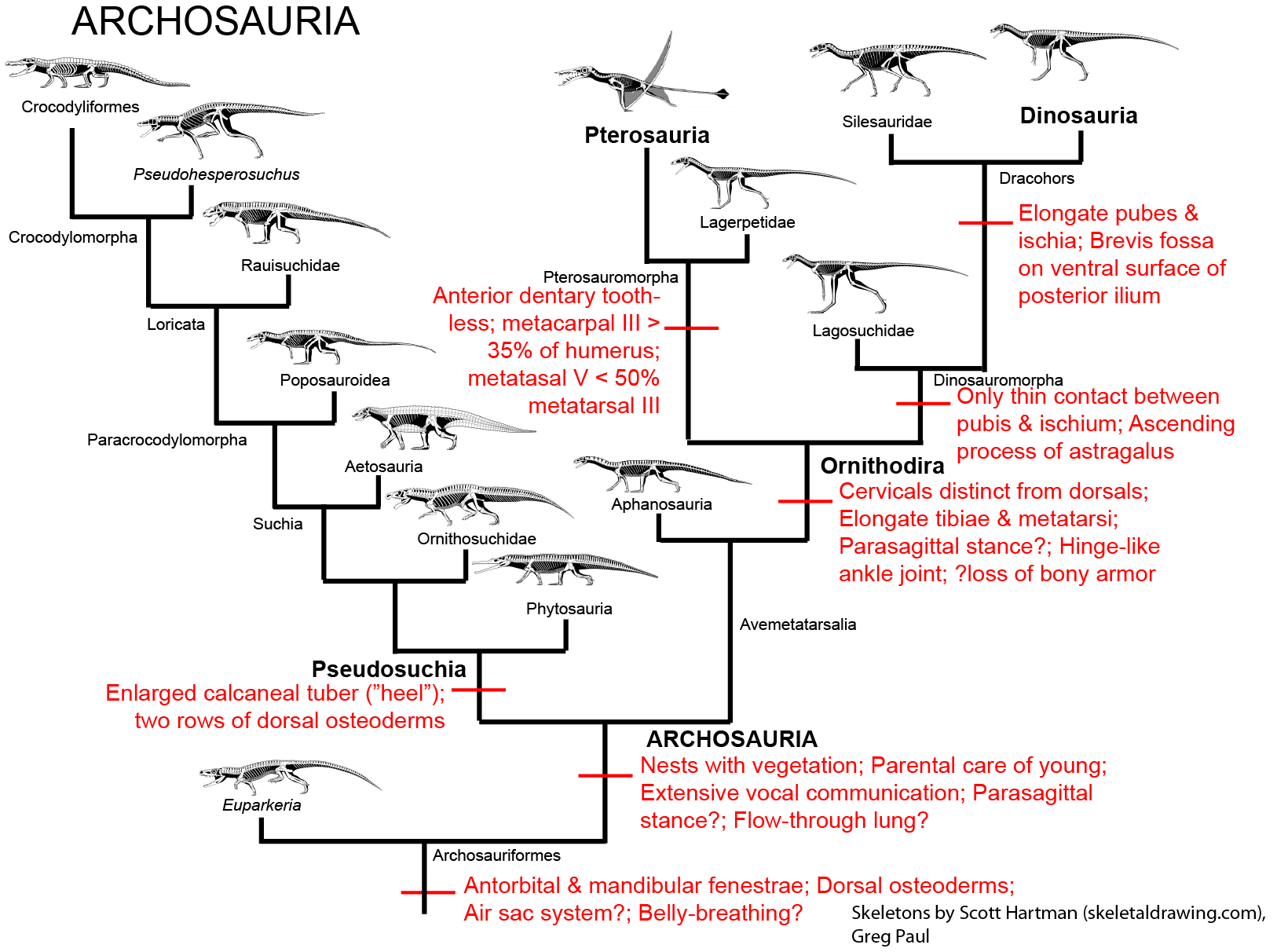
Archosaurs and their closest relatives are distinguished from other diapsids by:
It is not certain if these early archosauriforms had the behavioral traits found in both the living groups of Archosauria (that is, crocodylians and birds). Because both crocodylians and birds share the following derived traits, however, it is fairly certain that at least the concestor of all Archosauria had them, and passed them on to its descendants:
Middle and Late Triassic sauropsids, and diapsids in particular, radiate into many different forms:
A great diversity among the Middle and Late Triassic reptiles, though, were archosaurs. During the Middle and Late Triassic, the archosaurs displaced the therapsids as the dominant group of large terrestrial amniotes.
Archosaurs are divided into two main branches:
It is the pseudosuchians which dominated the Middle and Late Triassic. This group radiated into a number of forms:
The pseudosuchians include some of the first terrestrial animals to exceed the size of oxen and hippos. Most of them could stand with a semi-erect posture of the limbs, and a few had the fully-erect (that is, parasagittal gait).
Although pseudosuchians may have been the dominant group, plenty of other forms abounded in the Middle and Late Triassic. These included the last of the big beaked therapsid herbivores; more advanced, but generally small therapsids (including the oldest mammals: more about them later); many non-archosaurian diapsids (see above); and...
The First DINOSAURS!
In the shadow of the pseudosuchians, their sister group Ornithodira was present as rare forms. Initially quite small, ornithodirans are characterized by neck vertebrae distinct from the back vertebrae, and elongated lower leg bones. Among the ornithodirans are two main branches: Pterosauromorpha and Dinosauromorpha. Ornithodirans are characterized by the parasagittal stance with a simple hinge-like ankle joint and a digitigrade stance (that is, they walked on the balls of their feet).
Footprint evidence shows that dinosauromorphs were present within the first few million years of the Early Triassic, and body fossils during the Middle Triassic. The recently-discovered Silesauridae represents the (at least at present) closest known dinosauromorphs to Dinosauria proper.
Did the eventual success of the dinosaurs come from their adaptive advantages (so that they outcompeted the pseudosuchians)? Or was it due to circumstances independent of their morphology (that is, some kind of luck.)
If the former, what traits did the dinosaurs have that their "rivals" lacked? We already saw that dinosaurs had long striding legs, and were probably more efficient striders and faster runners than their contemporaries. Perhaps the ability to cover more ground led to dinosaurs being able to capture more resources than others in their world?
One suggestion is that Mesozoic dinosaurs, like their avian descendants, were "hot-blooded".
Among modern vertebrates, some gross generalizations:
Birds and mammals are warm-blooded; that is, they are warmer than the environment around them in typical temperate and colder environments. Crocodilians, lepidosaurs, turtles, amphibians, most fish, and almost all invertebrates are cold-blooded: their bodies are generally only about as warm as the general environment around them, so consequently they feel cool to the touch outside of tropical situations; in contrast, warm-blooded animals have temperatures largely independent of the outside temperature, so they feel warm to the touch. Need to be precise as to definitions of terms. "Warm-blooded" and "Cold-blooded" actually encompass several different (although related) topics:
A typical cold-blooded animal is an ectothermic bradymetabolic poikilotherm: needs to get its energy from the sun and fluctuates with external environment (but can moderate fluctuations by moving from sunlight to shade and vice versa); however, needs very little food (snakes can go weeks without feeding, for example). Cold blooded animals become torpid at night and in colder weather.
A typical warm-blooded animal is an endothermic tachymetabolic homeotherm: its body temperature is stable and activity levels can remain high for long periods of time, at night, and in colder weather; however, needs a LOT of food or will die (imagine the effects of not feeding a cat or dog for weeks!).
Additional issues to consider:
Why evolve such an expensive trait as endothermy? Some suggestions have included:
Note that it is not just mammals and birds that are "warm-blooded". For example, tunas, billfish (sailfish, swordfish, marlins), lamniform sharks (like great whites and makos), boid snakes (pythons, etc.; but only while brooding), and certain plants (which aren't "blooded" as such, but some can emit internally-generated heat).
When dinosaurs were first discovered, they were interpreted as being no more than gigantic cold-blooded lizards. However, as early as 1842 Owen (in the very paper in which he named "Dinosauria") speculated that dinosaurs may have been warm-blooded like mammals. During most of the 20th Century the model of dinosaurs as cold-blooded returned. Work by John Ostrom (of Yale University) and his colleagues and students (especially Robert Bakker) presented new information that dinosaurs were in fact warm-blooded. This hypothesis generated considerable research (both in support and in attempts to falsify it): this change in thinking about dinosaurs and renewed interest in dinosaurian studies has been termed the "Dinosaur Renaissance".
Among the lines of evidence supporting dinosaurian warm-bloodedness:
As Owen pointed out in 1842, dinosaurs all had parasagittal stance, a trait unique to endotherms in the living world. More recent considerations of this point out that the anatomy of dinosaurs shows that they were active striders with large locomotory muscles, and in some cases were even cursorial. These indicate that sustained rates of locomotion, and indeed selection for an active (foraging?) lifestyle. These traits are common in endotherms (who need to procure food more often, and are able to sustain longer term activity) and essentially unknown in ecotherms.
Ostrom pointed out that many dinosaurs had specialized feeding adaptations (grinding and slicing teeth in a variety of herbivores, or the flesh-shredding teeth of carnivores, and so forth.) The ability to shred, grind, or chew food is significant because it takes the same volume of food and increases the surface area/volume ratio (as you will see, SA/V is going to play a BIG role in physiology!!), and thus allows an animal to digest the food and get nutrients out of it more quickly. Not all dinosaurs had as complex feeding adaptations as hadrosaurids or ceratopsids, but all of them show some degree of increased chewing or shredding ability compared to a typical lizard or turtle.
It was also shown that dinosaurs (and non-mammalian therapsids) had a wide latitudinal range. In the modern world, the diversity of terrestrial ecotherms is very strongly controlled by ambient temperature, and thus is reflected in the latitude of the ecosystem: tropical ecosystems have tremendous numbers of ecothermic vertebrates, temperate zones much fewer, and polar ones none. Before the 1960s geologists and paleontologists used the high diversity of polar Mesozoic dinosaurs (and Permo-Triassic therapsids) as evidence that those regions were tropical at the time. But he pointed out that if these animals were partly- or fully-endothermic, we would expect a higher diversity even in cooler climates. Additional paleoenivornmental work shows that while these intervals in time were generally warmer than today, the polar regions were far from tropical, and yet therapsids and dinosaurs were common there. Recent work on Late Triassic ecosystems confirms a much broader environmental tolerance for ornithodirans (including dinosaurs) and therapsids (including early mammals) than in contemporary pseudosuchians and amphibians.
An attribute of dinosaurs which has been obvious for a long time but has a bearing on this issue is that big dinosaurs are tall. John Ostrom pointed out the reason this is important is that in order to get blood way up the brain requires a very active heart, which requires a high metabolic rate. Big ecotherms can get away with being big because they are or were built low to the ground: the brain wasn't held way above the ground, so the heart need not work as hard and strong.
Bone histology (microscopic analysis of tissue and cellular structure) can test between bradymetabolic and tachymetabolic organisms. Bone becomes reworked (that is, removed then redeposited) as a normal part of vertebrate physiology, as bone is a major store for nutrients like calcium and phosphorus. Bradymetabolic animals show little sign of reworking, as their slower metabolism does not need as much nutrients as quickly. In contrast, tachymetabolic animals show considerable reworking. Examination of the bones of dinosaurs show a high degree of reworking, even as juveniles.
Using skeletochronology, the maximum rate of growth of dinosaurs can be calculated. When plotted against body size, it is found that dinosaurs had much higher growth rates than ectotherms of the same size; in fact, the dinosaur growth rate is about the same as mammals and ground-dwelling birds. (We'll talk more about dinosaur growth next lecture.)
Texture of bone also shows signs of the rate of growth. Dinosaurs show fast rates similar to mammals; pseudosuchians and other archosauriforms show an intermediate rate; and ectotherms show a slow growth rate.
Related to the above are estimates of bone apposition rate (the rate at which new bone is added onto older bone. Once again, pseudosuchians and other non-dinosaurian archosauriforms show a higher rate than in extant ecotherms. Within dinosaurs, the non-theropod dinosaurs show rates comparable to modern mammals, and Mesozoic theropods show rates comparable to modern birds (the fast living bone-growers.)
Examining the nutrient foramina (holes for blood vessels into and out of bones) in dinosaurs shows that the amount of blood flowing through dinosaurs greatly exceeded modern ectotherms, and even modern mammals. This suggests that the metabolic rate of dinosaurs was indeed very high.
The size of the blood vessels inside bone give us an approximation of maximum blood cell size. It has been found that on average, ecotherms have larger blood cell sizes than endotherms: because smaller objects have a larger surface area/volume ratio, a smaller red blood cell can more quickly dump off its waste carbon dioxide and pick up fresh oxygen than a bigger one. Based on blood vessel size, silesaurids and Mesozoic dinosaurs had red blood cells comparable in size to modern flightless birds and the pre-mammal therapsids. (Modern flying birds have even smaller red blood cells, and mammals (who have lost the nucleus in their red blood cells) are the smallest of all.)
Comparison of the bone oxygen isotope data of dinosaurs with known ectotherms of the same environment (modern-style crocodilians, turtles, and amphibians) finds that the dinosaurs show lower body temperatures in the hottest environments and lower body temperatures in moderate and colder environments. This suggest that dinosaur body temperatures were independent of the local environment.
A related approach is to look at egg oxygen isotope data. The egg shell takes on the isotopic characteristics of the temperature at which it formed, which was inside the mother! It has been found that titanosaur eggshell show high temperatures, but these could conceivably reflect gigantothermy rather than endothermy. However, ornithischian and theropod eggs of much smaller dinosaurs show similar temperatures, but these temperatures would be too high to explain by size-based temperatures.
Computer models of the required metabolic rates required for even walking and slow running for large bipedal dinosaurs exceeds the metabolic rate of ecotherms. So if they actually moved, big theropods HAD to have been endotherms. In fact, the proportionately massive hindlimb muscles of all dinosaurs likely generated enough heat to keep the temperature elevated.
So You Want To Be An Endotherm?
Let's consider the equations of life. First, the aerobic respiration equation, the primary means by which animal cells operate:
C6H12O6 + 6O2 yields 6CO2 + 6H2O + Energy
(That is, food (glucose) plus oxygen yields waste carbon dioxide and waste water, plus energy).
If an animal's cells can't get enough oxygen, there is a second way of getting energy: the anaerobic respiration equation:
C6H12O6 yields 2C3H6O3 + Energy
(That is, food yields lactic acid plus energy (although much less than the aerobic respiration.) Lactic acid itself needs oxygen to break down, so you cannot run on anaerobic respiration for very long.
If you want to evolve endothermy, you need to:
So, where do we stand on dinosaur metabolism?
Efficient Heart and Lungs: Turtles and lepidosaurs (lizards, snakes, and tuataras) have three-chambered hearts, while birds, crocodilians, and mammals have four-chambered hearts. Four-chambered hearts have certain advantages over the ancestral three-chambered variety:
But it looks as if dinosaurs did have enhanced forms of respiration. Primitive tetrapods are subject to Carrier's Constraint: the same muscles for breathing are used for locomotion (bending from side-to-side). Thus, most primitive tetrapods tend to hold their breath while breathing, meaning that they rely more on anaerobic respiration and require long recovery intervals.
Various clades evolved methods to increase the amount of oxygen they obtained. Mammal-style diaphragm breathing is an advanced therapsid feature; most tetrapods breath by gulping air and by rib breathing. Some specialized lizards developed neck breathing separate from rib breathing.
Modern crocodilians their own specialized breathing:
The living dinosaurs (birds) have extremely specialized breathing:
There is speculation that a form of belly breathing is an archosaurian synapomorphy:
The net evidence is that dinosaurs had a better ability to oxygenate their body than their contemporaries.
What would be necessary to justify the above observations?
Is there evidence for these features in dinosaurs? YES!:
Heat enters and exits the body of the surface area, but it is generated internally by the mass of the body (in other worlds, in volume.) So the the ratio of the surface area to the volume is a metric of how quickly (or slowly) heat would leave the body. But from geometry, as linear dimensions double, the surface area goes up by squares, and the volume by cubes:
| Side Length | Surface Area (SA) | Volume (V) | SA/V |
|---|---|---|---|
| 1 | 6 | 1 | 6/1 = 6 |
| 2 | 24 | 8 | 24/8 = 3 |
| 3 | 54 | 27 | 54/27 = 2 |
| 4 | 96 | 64 | 96/64 = 1.5 |
Thus, as size increases, SA/V decreases. Therefore, with bigger body size it takes longer and longer for heat to be lost or gained.
Indeed, very large animals potentially become gigantothermic: homeothermic (stable body temperature) without having the energy costs of endothermy! But did dinosaurs do this? A recent (2020) analysis found that body temperatures of dinosaurs were about the same regardless of whether they were small, medium size, or gigantic. And only the gigantic ones were temperatures that would have been the result of gigantothermy.
Warm-blooded Protocrocs?: Most studies assume that endothermy evolved sometime after the bird lineage (Ornithodira) and the crocodilian lineage (Pseudosuchia) diverged from each other. This is because crocodilians are ectotherms, as are all the next several outgroups (lepidosaurs, turtles). However, what if crocodilians were not ancestrally ectotherms, but instead reverted to a cold-blooded physiology from warm-blooded ancestors?
There is some evidence that this is the case:
Mighty Mites: The Possible Role of Miniaturization in the Rise of Endothermy
It has long been observed that the two major groups of terrestrial endotherms (mammals and birds) both originated as quite small animals compared to their relatives. Furthermore, the ancestral lineages from which they were derived show indications of elevated metabolisms that don't rise to the level of full endothermy. So some have suggested that proto-endothermy arose in pre-mammalian therapsids and non-avian theropods to allow increased activity levels, and that the shift to tiny size (and its necessity for such things as increased insolation and the general allometric aspect of increased metabolic rate in smaller animals anyway) pushed them to true endothermy.
There is some merit to this thinking, but in your instructor's opinion the transition in avian history did not occur WITHIN Theropoda, or even Dinosauria. The shrinking of body size at the base of Eumaniraptora is not the only case of miniaturization in the lineage leading to birds. As you recall, the first members of Ornithodira were small-bodied forms (Scleromochlus, lagerpetids, lagosuchids, etc.), and from that point onward both pterosauromorphs and dinosauromorphs show considerable evidence for high metabolic rates. Indeed, we have evidence of insulation in both Pterosauria and (possibly) at the base of Dinosauria, and quite frankly no positive evidence of its absence in other pterosauromorphs and dinosauromorphs: fuzz might well be an ornithodiran trait!
So one reasonable hypothesis is that the switch to some form of endothermy occurred not with the origin of birds, but rather with the origin of Ornithodira.
In our present knowledge of the Triassic, ornithischian dinosaurs have yet to be definitely recognized, and theropods were only secondary predators compared to the pseudosuchians. But sauropodomorphs were far more successful: starting at a mere 1-1.5 m long, they grow to 10 m by the end of the Triassic. Their success was likely due to the fact that they could feed high in the trees, unlike other contemporary herbivores.
Triassic pseudosuchians were more diverse in terms of morphology and more speciose than ornithodirans at this time. However, when the Triassic/Jurassic extinction occurred very few of the pseudosuchians survived (only small-bodied ancestors of the crocodilians). Additionally, the therapsids survived only in the form of early mammals, 5-10 cm. In contrast, the dinosaurs did much better. At the dawn of the Jurassic, dinosaurs were the dominant group of terrestrial animals, and underwent a major adaptive radiation.
So most of the the Late Triassic is the time WHEN DINOSAURS SHARED THE EARTH!. Pseudosuchians remained ecologically diverse and important, and (especially in the early Late Triassic) non-archosaurian archosauromorphs and therapsids were also significant. In the later Late Triassic (in Gondwana and Europe, at least) things shift: pseudosuchians remain important (especially in the form of paracrocodylomorphs, aetosaurs, and phytosaurs) as did dicynodont therapsids, but sauropodomorphs expand in diversity (and size!). In recent years it has been suggested that a major environmental shift was the cause of this. Sedimentological analysis shows that the world got considerably wetter from 234-232 Ma. Its particular trigger isn't well understood, but it affected life on both land and sea. This event occurred in the Carnian Stage, and so is called the Carnian Pluvial Event ("pluvial" = "of or concerning rain"). One of the changes on land is the diversification and spread of groups of tree-sized plants (especially conifers and the now-extinct cycadeoids). It has been argued that the accumulation of this new leafy biomass may have promoted the expansion of the sauropodomorphs, and thus of Dinosauria.
(That said, the phenomenon is NOT apparent in North America! Both the excellent body fossil record of the Southwest and the trackway record of the East show no spread of sauropodomorphs, or dinosaurs in general, in North America in the later Carnian and subsequent Norian and Rhaetian stages.)
At the end of the Late Triassic, though, there was a mass extinction that affected the entire planet: the Triassic-Jurassic Extinction. The primary trigger seems to have been a period of tremendous volcanism in the middle of Pangaea. 201 Ma saw the beginnings of the rupture of the supercontinent of Pangaea, between the landmasses that are today North America, Europe, and Asia (on the north) and South America, Africa, and the other continents (to the south). This produced the Atlantic Ocean in the long term, but for the inhabitants of the Earth at the time suffered.
A vast amount of greenhouse gasses (both carbon dioxide and methane) were released, producing catastrophic global warming. But this was preceded by a burst of sulfur dioxide, which produced a rapid phase of cooling. There is additional evidence that poisons like mercury were released into the environment.
These massive pulses of environmental change were too much for many groups of organisms to survive. This is one of the five greatest mass extinctions known, with many terrestrial and marine taxa wiped out. Among terrestrial vertebrates, some of the main victims were:
With no serious competition remaining, dinosaurs radiated into numerous forms. From the beginning of the Early Jurassic onward, DINOSAURS RULED THE EARTH.
In the wake of the Tr/J Extinction, dinosaurs underwent a major adaptive radiation:
We'll examine the issue of giant size in dinosaurs in the next lecture.
A video about Triassic reptiles:
And one about the Carnian Pluvial Event:
An overview of dinosaur topics:
Here is a video about our changing understanding of dinosaurs over time:
And a review of Mesozoic reptile history:
The Raptor That Made Us Rethink Dinosaurs:
The Facts About Dinosaurs & Feathers:
5 Things You Should Know About Dinosaurs:
